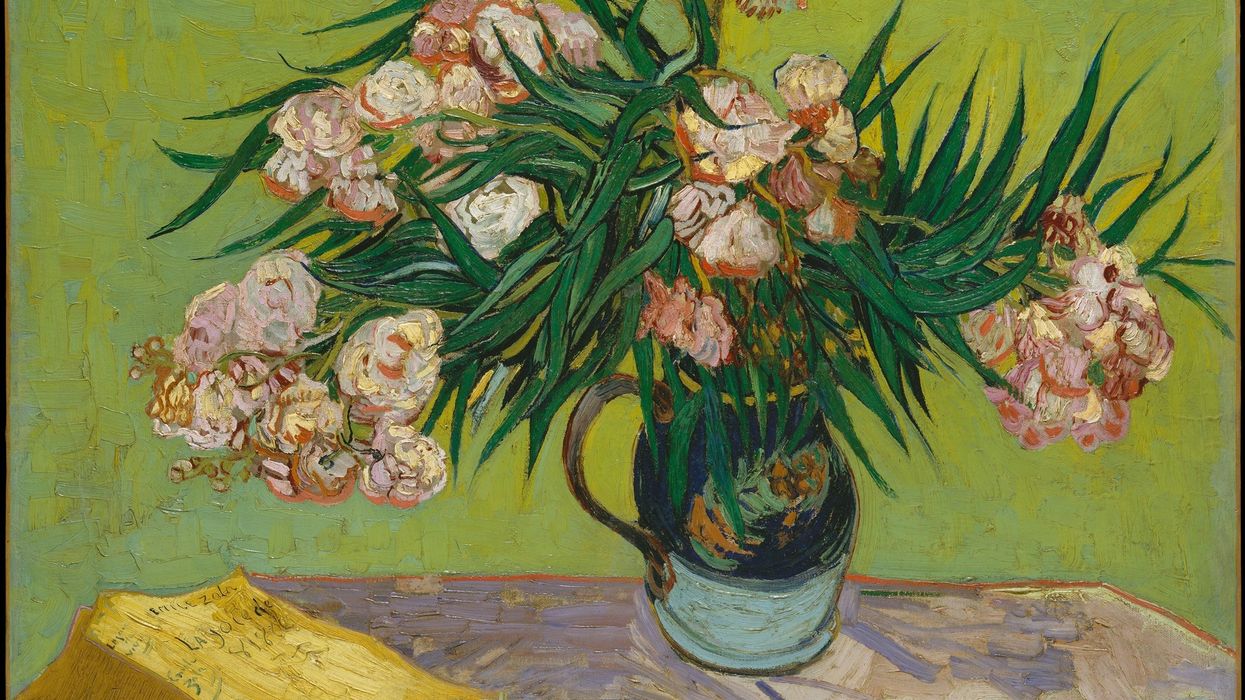VAN GOGH’S Sunflowers are among the most recognised artworks, and a new exhibition at the National Gallery brings both these paintings together for the first time after they were last seen in the Dutch artist’s studio.
This year marks the centenary of the acquisition of one of the Sunflowers paintings by the London museum, which itself is marking its 200th year in 2024.
Van Gogh intended the artworks to be displayed as a set of three, and so the two Sunflowers paintings (one made in 1888 and the second, a year later) flank La Berceuse (1889), a portrait of a woman with cradle cord.
Van Gogh: Poets and Lovers will be the National Gallery’s autumn blockbuster show, with more than 50 artworks sourced from within the gallery as well as European and US museums and some private collections.
At a preview of the exhibition before it opened to the public last Saturday (14), co-curators Cornelia Homburg and Christopher Riopelle explained the significance of the two years Gogh spent in Arles and Saint-Rémy in Provence (1888 -1890), a time when he was admitted to the Saint-Paul-de-Mausole hospital in Saint-Rémy.
This is the first time the second Sunflowers has travelled outside the US museum. Writing to his brother Theo in May 1889, Van Gogh discussed potential arrangements of them for display and sent him a sketch.
Vincent Van Gogh’s Self-Portrait (1889)The painting between the two Sunflowers is a portrait of Augustine Roulin, the wife of his friend, the postmaster of Arles. In her hands she holds the end of a rope, suggesting an unseen cradle.
Its title, La Berceuse, can be translated as “lullaby” or “she who rocks the cradle.” Van Gogh told his brother he imagined his painting “in the cabin of a boat” where fishermen in “their melancholy isolation, exposed to all the dangers, alone on the sad sea…would experience a feeling of being rocked, reminding them of their own lullabies”.
Homburg said while in the south of France, Gogh explored the countryside and used the motifs from nature and the models he had to create some exceptional works of art. “And often these are inventions. These are inspired by his imagination and by an incredible array of interpretations of motifs,” she added.
The Bedroom (1889)In Arles, Gogh designated an unremarkable (as Homburg described it) public park in front of the Yellow House (in which the artist lived and worked) as a Poets’ Garden, envisioning Italian Renaissance poets Petrarch and Boccaccio strolling there. Visitors are greeted by three paintings that dominate the first room, a lover and a poet on either side of The Poet’s Garden.
In the spring of 1889, Homburg recalled how after Gogh had a number of breakdowns and was afraid of living on his own, he had himself committed to a psychiatric hospital in Saint Remy.
There, he goes into the somewhat unkempt garden of the hospital, and again, sees “opportunities to make different interpretations, different depictions of a relatively small and closed space”, she said. “He imagines little corners, he referred to nests of the lovers, imagining that in this manner. Of course, it couldn’t be the case, but that’s how he interpreted the place in his mind.”
Those paintings, depicting a setting sun, a broken tree trunk, all symbolise the suffering of his fellow patients.
Night over the Rhône (1888)In a letter to his friend, Emile Bernard, a French painter and writer, Gogh said, “You’ll understand that this combination of red ochre, of green saddened with grey, of black lines… gives rise to a little to the feeling of anxiety from which some of my companions in misfortune often suffer.”
Van Gogh drew inspiration from Paul Gauguin and a Japanese print for The Sower, a rural scene of a solo figure with a large tree trunk diagonally cutting across the canvas and the bright sun bestowing a halo-like effect on the sower.
Elsewhere in the show are more artworks with themes of nature, featuring flowers, mountains, wheat fields, meadows, olive trees – all stunning for their vibrant use of colour, brushwork, innovation and interpretation.
A set of paintings in the last room of the exhibition were done prior to Van Gogh leaving Arles and travelling up north.
“He paints in a very exciting new way, he gives these incredibly close up looks, as if he’s staring straight down at nature in front of him,” said Riopelle, describing how they’re “almost abstract in their boldness, in the originality of the composition”.
This is the National Gallery’s first exhibition devoted to Van Gogh, and it includes his famous drawings, too.
The Olive Trees. (1889) Artwork Location: Museum of Modern Art (MoMA), New York, USAThose with a keen eye will notice sunflowers at the bottom of a canvas of mountains, which Van Gogh interpreted in his own way.
In another painting of his studio, two portraits hang on the wall next to his bed – one of them is his self portrait, which is placed alongside the painting of the studio. The other portrait is of a blonde person, which Homburg said has never been found, so “there is another story he’s telling us, imagining it possibly – an affair or an intimate encounter”.
Intrigue, innovation and imagination come alive in this show which will captivate long time art lovers as well as novices.
Van Gogh: Poets and Lovers until January 19, 2025 at the National Gallery




